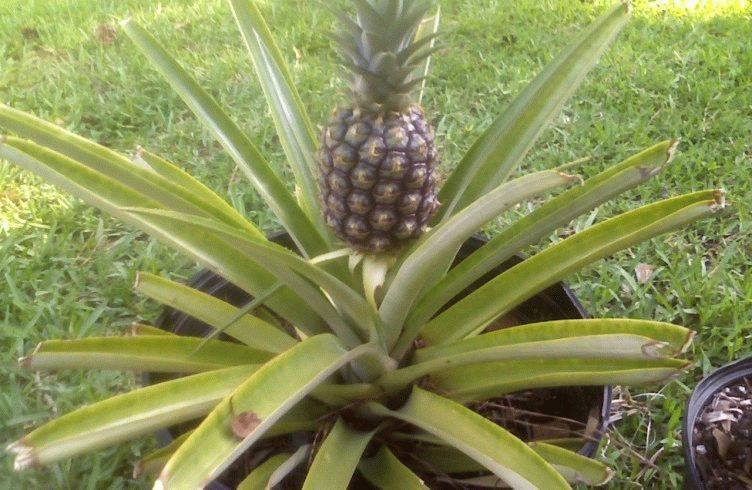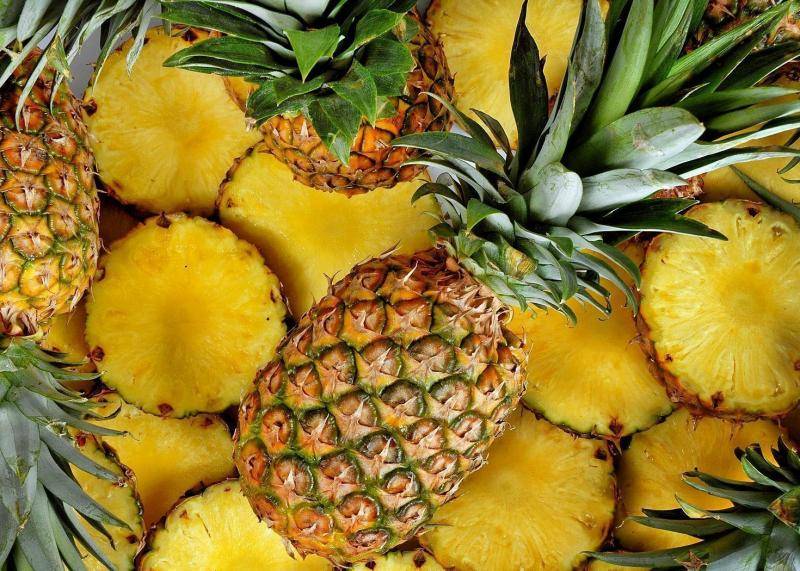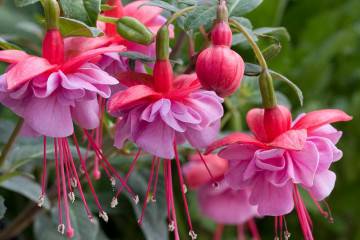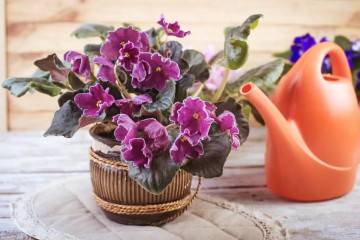How to grow pineapple at home
Content:
Pineapple is an exotic plant that most flower growers try to grow at home. Unfortunately, not every flower lover is able to grow a perennial from seeds. How to grow pineapple at home and is it possible? Below is information to help you plant and care for your crop properly.
Step-by-step instructions on how to grow pineapple from the top of the house
Most flower growers have tried at least once to grow a perennial herb, which is a member of the Bromeliad family. Pineapple is a crop that can be grown from the "tuft" (top).
To grow a fruit perennial at home, you should use:
- seed material;
- cuttings;
- the tops of the fruits.
To simplify the process, it is advisable to go to the retail network and purchase quality fruits. When choosing, you should pay attention to:
- Freshness and ripeness of the fruit. Ripe pineapple fruit will exude an amazing aroma, as strong as citrus fruits.
- No rot and damage to the fruit. Each fruit must be inspected carefully before purchasing. The presence of stains indicates damage to the fruit.
- Fruit color. What does a ripe pineapple look like? The fruit should be yellowish in color. The presence of green on the skin indicates immaturity.
- The crown color should be green. At the same time, the tips should dry out slightly. Fruits with yellow foliage are not suitable for growing, so it is best to leave them on the counter.
Preparing the crown for rooting
Before growing pineapple from the "tuft", you should do the following:
- Cut off the top of the exotic fruit. The lower foliage is pinched off.
- Remove the pulp with gentle strokes. It is important not to damage the peel.
- The cut off top must be turned over and left to dry for 4-5 days. After the specified period of time, the cut area will become more rigid.
Rooting pineapple at home
After carrying out the preparatory procedures, they start rooting the pineapple:
- The top of the exotic fruit should be placed in a container filled with water.
- The crown is left in water for 7-10 days.
- After a week, the tip should take root.
- The water must be changed daily to avoid clouding.
Landing
How to plant a pineapple at home so that it soon pleases with fruiting? The pineapple top should be planted in light soil for indoor plants. The height of the planting container should be 15 cm:
- A layer of expanded clay and river sand is poured onto the surface of the bottom of the tank. Instead of expanded clay, a layer of perlite can be used.
- After the drainage layer, leaf or sod soil is filled up. You can also use commercially available soil, which is produced for cacti.
- In the soil it is necessary to make a depression into which the lower part of the stem is placed. The deepening is covered with a layer of soil.The main part of the rosette should remain on the surface and the stem should sit in the soil.
- The soil is abundantly moisturized. The upper part of the planting is covered with a plastic bottle (volume 5 l).
- The container should be placed in a warm and well-lit room. The soil should be moist, but not waterlogged.
- Seedlings need watering once a week. It is worth fertilizing every month.
- Flowering can be expected soon. A red cone is formed first, then blue flowers appear. From the moment of flowering until the fruit ripens, it should take about 5.5-6 months.
Care features
Pineapple needs proper care. Below you can find the basic recommendations for the care of this exotic plant.
Watering and feeding
To moisten the soil, it is necessary to use rain or melt water. The temperature of the watering liquid should be about 29-30 degrees. Water is poured into the outlet area. Water the pineapple as the top layer of the earth dries up.
Top dressing is applied every 10 days. Experts recommend alternating mineral fertilizers with organic ones. Horse or cow dung is perfect as an organic top dressing. Mineral dressing should be liquid.
Pepecadka
Pineapple transplanting should be carried out by the transshipment method. The earthy clod on the root system cannot be destroyed. Transfer work is best done in the spring. The volume of the container should be slightly larger than the previous one. With gentle movements, the pineapple waddles from one pot to another. The root system, together with the soil, is planted in a prepared hole. The deepening is covered with a layer of soil. The earth is abundantly moistened.
How pineapple grows in nature
Pineapple belongs to the herbaceous category. Under favorable conditions, a perennial can grow up to 150 cm. Inflorescences-cobs form at the top of the plant.
What do pineapples grow on and what does a pineapple tree look like?
Since the plant belongs to a herbaceous culture, it can be understood from this that the fruits do not grow on a tree. The herbaceous crop grows to only 150 cm. From a distance, the pineapple planting area resembles fields with cabbage. The long leaf blades are quite sharp. The fruits are formed in the central part. They cannot be classified as vegetables, despite the fact that the pulp is often used in the preparation of salads.
The homeland of the exotic fruit is the territory of Africa, South America and Thailand. The full maturation process takes about 5-9 months. If you collect fruits that still need to ripen, then when eating the pulp, you may experience burning sensations of lips and tongue, as well as food poisoning.
Bloom
How exactly does pineapple bloom? After a year of active growth, the perennial begins to release spike-shaped inflorescences with a large number of flowers from the upper part. Their shade can be:
- red;
- burgundy;
- purple.
A berry is subsequently formed from each flower, which grows quickly and is filled with juice. In the case of successful pollination of flowers, seed material can be found in the berries. The presence of seeds negatively affects the taste characteristics of the fruit.
After the first fruit has ripened, the culture begins to release side shoots, which are often used for vegetative propagation.
For a good harvest, you need to take care of:
- using high quality planting material;
- pest and weed control;
- the introduction of mineral dressings into the soil.
Indoor pineapple or pineapple in a pot
Pineapples can be grown indoors. Below you can find out about the features of planting and caring for the crop.
Decorative pineapple
For growing in apartment conditions, it is better to give preference to such varieties as:
- Kaena is the oldest variety, the height of which reaches 30 cm. The fruits are quite juicy and tasty. They contain a large percentage of calcium, iodine and magnesium.
- Large-crested - perennial, the height of which can exceed 70 cm. Fruits of a yellow-golden hue begin to form 5 years after planting.
Features of caring for pineapple in a pot at home
A perennial herbaceous crop needs warmth, so even in the cold season, the indoor temperature should not drop below 22 degrees. It is best to place pots with an exotic plant near the windowsill. In the autumn and winter months, additional lighting will be required. For this purpose, it is worth using fluorescent lamps. The backlight duration should be up to 9 hours a day.
In the summer months, it is necessary to carry out abundant and systematic soil moistening procedures. In the cold season, it is enough to water the pineapples 2 times a month. On hot days, it is advisable to carry out a "warm shower", thanks to which the foliage of the culture will be filled with moisture. You can prepare the soil for planting yourself. To do this, you need to connect in equal parts:
- humus;
- sod soil;
- sand and crushed peat.
The substrate is loose.
Diseases, pests and possible problems
When growing exotic plants, problems can arise. The most common are:
- Drying of the tips of the foliage. Occurs against a background of too dry air. To cope with the problem, it is necessary to raise the humidity level.
- Mold in a pot occurs against the background of frequent soil moistening procedures in the cold season. In this case, the mold is removed, and the frequency of watering is reduced.
- Root decay is most common when grown in a humid room. In this situation, it is important to trim the bottom of the trunk down to healthy tissue. At the same time, the apex takes root.
- Slow growth. To accelerate growth, you will need to move the pineapple pots to a warm room.
Growing pineapple from seeds at home
The seed method is the most laborious and complex. It should be borne in mind that seedlings will appear only from purchased seeds. From those seeds that were found in purchased fruits, pineapples will not germinate.
The seed that will sprout is naturally endowed with a simplified semicircular shape and is colored in brown tones. Its length reaches 4 mm.
- Before planting, the seed is placed in a damp cloth for a couple of days and transferred to a warm room.
- After the seeds have swollen, it is worth preparing a container filled with a mixture of peat and sand.
- Seeds are sown in a container with a substrate.
- The soil is moistened, and the container is covered with glass. The seed pots are transferred to a warm room.
- Seedlings can be expected after 4-7 weeks.
- It is very important that during this period the temperature in the room is in the range of 25-27 degrees. The soil should be moistened every 3 days.
- From 3 weeks after planting the seeds, it is necessary to make complex fertilizing.
- As soon as the second pair of foliage is formed on the sprouts, the seedlings can be cut into separate containers. For planting, it is worth using a soil mixture, which includes a small part of humus, perlite, peat, garden soil and sand. The soil is mixed with charcoal (5%).
Reproduction in nature
Under natural conditions, the culture can be propagated using the top and the seed method.
To perform the first method, you will need to cut off the top and plant it in the ground. The cut tuft is a valuable planting material. Unfortunately, this method is not always a guarantee that the herbaceous perennial will please with fruiting.
The seeds that can be found in the cells under the skin are similar in appearance to the seeds from apples. Seed material flies from overripe open pineapples from gusts of wind and spreads throughout the plantation. A plant grown in this way in natural conditions will delight with fruiting in 24 months. In the wild, the crop can be propagated exclusively by seed.
Pineapple is an amazing herb that today can be learned to grow even at home. The most important thing is to adhere to the recommendations regarding the care of the crop and systematically apply top dressing to the soil.






















